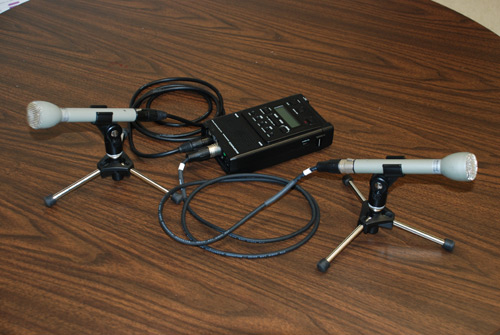Guest column by Peter Welander, Control Engineering process industries editor.
Last week we examined a group of portable digital recorders in the $200 to $300 price range. Are those enough for producing high-quality podcast recordings, or should you be looking for something more expensive?

Do you really need all this to record a podcast? That’s a lot to carry to a trade show.
Any of the “music” recorders discussed last week should be able to produce satisfactory sound quality if used skillfully and recording conditions are cooperative. When you have a relatively quiet room and participants who speak clearly, the task is pretty easy.
If you spend more on a recorder, you should expect something for your money:
- Extended features;
- Greater durability;
- Higher overall “quality;” and
- More versatility.
Extended features in this arena may apply more to field recording of music, which doesn’t necessarily help us working on podcasts. On the other hand, some designs are aimed more at professional broadcasters who are trying to do recording in the field. Those might help but could simply lean more on you to provide the skill. More on that later.
Greater durability is important if you want to throw your recorder in a briefcase and drag it around with your laptop. If it gets crushed in the overhead bin on your next flight, or when the microphone breaks off, that’s a problem. Unfortunately, it’s difficult to judge relative durability from a Webpage or catalog.

Higher overall quality in this context can relate to better microphones, reduced recording noise and hiss, wider frequency response, etc. Such improvements may be aimed at better music recording, but these also help getting better speech. The question is, are they worth it for our purposes? Probably not in most instances.
Versatility is also hard to quantify in our context. Many recorder features support better music capture. Truth to tell, for podcast recording, we need a pretty short list of capabilities. What versatility we do need comes primarily from adding different types of microphones. As long as the recorder supports that, there really isn’t much else.
With that in mind, let’s look at a few possibilities in the $400 and higher bracket:
Edirol (Roland) R-09 and R09HR
This unit has some very sophisticated features for music recording and excellent built-in microphones. I know a conservatory professor who records pipe organ recitals in a huge concert hall with one of these, and he really likes the results. Should you buy one for podcasts? Sure, but it’s overkill.
Marantz PMD620
 Marantz has been making broadcast-grade recorders for years, including cassette tape, mini disk, direct to CD, and now digital card. This unit is relatively new and the company’s first foray into pocket-size designs with usable on-board mics. It is optimized more for speech recording and has features aimed particularly at broadcast journalists and podcasters. Durability should be high, but reviews on this topic vary. One major drawback (to my thinking) is that it does not have XLR mic inputs. Of course there are ways to get around that and still use professional microphones. If you’re serious, you should explore this unit. It should provide a good bridge between amateur and pro recording.
Marantz has been making broadcast-grade recorders for years, including cassette tape, mini disk, direct to CD, and now digital card. This unit is relatively new and the company’s first foray into pocket-size designs with usable on-board mics. It is optimized more for speech recording and has features aimed particularly at broadcast journalists and podcasters. Durability should be high, but reviews on this topic vary. One major drawback (to my thinking) is that it does not have XLR mic inputs. Of course there are ways to get around that and still use professional microphones. If you’re serious, you should explore this unit. It should provide a good bridge between amateur and pro recording.
Once you get to this point, you either need to stop looking or prepare yourself for moving to a whole new level.

Marantz PMD660
At $500, this is the threshold of professional broadcast recording equipment. The PMD660 pushes you into the world of external microphones, cables, headphones, and the whole works. But, it is designed specifically for the kind of recording you need to do for podcasts. The list of features is very short, but they are exactly the ones you need if you want to do very high quality work:
- It has onboard mics, but they are worthless. You need to be using external mics.
- Full manual and automatic recording levels, but best when working in manual.
- Once it’s set up to your preferences, and you’ve gotten used to it, operation is very quick and easy.
- Supports recording in stereo or mono.
- Big (3x the size of pocket units), heavy, but very durable.
But, bear in mind that buying the recorder is only the beginning. You need mics, cables, stands, etc. It is a much different type of commitment, but can provide versatility that will allow you to record in difficult situations.
You can find units used for $300-350. I have one I bought on eBay in that neighborhood.
There are many ways to achieve high quality podcasts. As with most things, with a reasonable amount of effort, you can get 70% of the way there. Once you move past that point, each incremental advance requires more energy and possibly more equipment. Most editors that I’ve talked to seem to have a high tolerance for crummy production values. I don’t think this reflects an unwillingness to make an effort as much as a frustration not knowing how to make it work. In other words, it’s a training issue. How can we help advance our capabilities?
